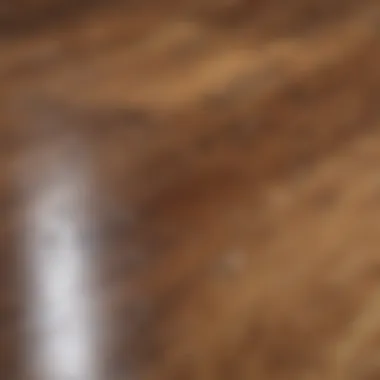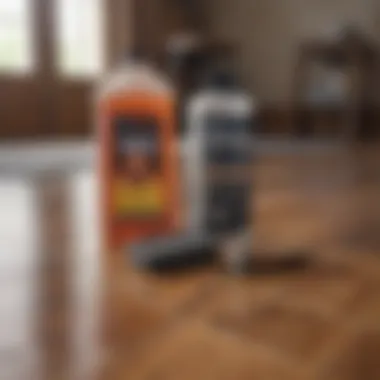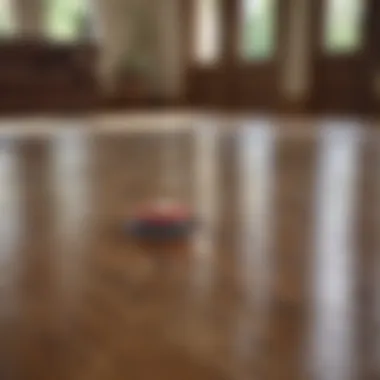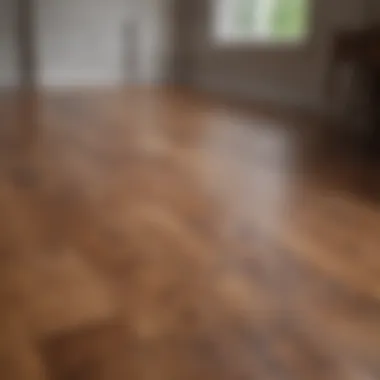Effective Methods for Removing Grease from Hardwood Floors


Intro
Hardwood floors exude elegance and charm, lending character to any space they adorn. However, they can also fall victim to grease buildup, particularly in areas like kitchens or dining spaces, where oil splatters and food particles are commonplace. Knowing how to effectively address this issue is crucial for homeowners wishing to maintain the pristine condition of their floors.
Grease not only compromises the beauty of hardwood but can also lead to long-term damage if left untreated. The first step in tackling this pesky problem is understanding its causes.
In this guide, we’ll journey through various techniques and methods for banishing grease from your beloved hardwood floors. From the necessary tools and materials to practical cleaning techniques, we will cover every inch of this topic. We will also highlight common mistakes to steer clear of, ensuring you keep your floors looking sharp for years to come.
So roll up your sleeves and let’s dive into the nitty-gritty of grease removal!
Feature Spotlight
When dealing with grease on hardwood floors, it’s essential to consider the unique characteristics of your flooring. Hardwood can be diverse, and there are several factors that contribute to its maintenance.
Exceptional Architectural Designs
Many homes boast hardwood flooring as a showcase feature. From wide plank designs to intricately patterned styles, these floors often represent a hefty investment. It’s essential to honor this investment by properly maintaining them, especially when battling grease stains.
Unique Decor Elements
Consider the decor elements that complement your hardwood floors. Vivid area rugs or vintage furniture can add character but may also harbor dirt and grease if not cleaned regularly. Using durable cleaning methods is key to preserving both the floor and the furnishings.
Common Mistakes to Avoid
"A stitch in time saves nine."
When cleaning grease from hardwood floors, some mistakes can lead to more significant challenges down the line. For instance:
- Using abrasive cleaners: These can scratch and damage the finish of your hardwood.
- Ignoring immediate spills: Prompt attention to grease spills can avert disastrous stains.
- Over-wetting the floor: Excess moisture can seep into hardwood, causing warping over time.
By being vigilant and aware, you can maintain the integrity of your hardwood while ensuring it stays beautiful.
Now, let’s examine the most effective cleaning methods to restore that glorious sheen!
Closure
Understanding the tendencies of hardwood floors regarding different contaminants goes a long way in maintaining their allure. The techniques explored here will aid in effectively managing grease and fostering a cleaned, healthy living environment.
Understanding Grease on Hardwood Floors
Understanding grease on hardwood floors is crucial for anyone who values the aesthetic and functional integrity of their flooring. Grease stains are not just unsightly; they can lead to significant long-term damage if not addressed properly. The very beauty of hardwood can become dulled or scratched, and over time, these blemishes might lead to a need for costly refinishing. Thus, grasping the nature of grease accumulation, its origins, and effects is a first step in maintaining your floors and keeping your home looking sharp.
Origin of Grease Stains
Grease stains often have a rather mundane origin, arising from everyday activities. Cooking is one of the main culprits. Picture a busy kitchen with sizzling pans and spattering oils. It's not hard to imagine how droplets can land on your hardwood. Even something as seemingly innocent as carrying a pizza to the dining table can leave behind greasy fingerprints. Moreover, pets can add to the mix, bringing in oil from their fur or paws after a romp outside. Sometimes, simply living in your space leads to grease build-up.
And let’s not forget about the tiny particles that accumulate over time. Dust, dirt, and assorted grime can blend together with moisture, creating a sticky surface that holds grease even more tightly. This compound cocktail isn’t just annoying to look at; it can also be hard to remove if allowed to settle.
Impact of Grease on Wooden Surfaces
The impact of grease on wooden surfaces varies, yet the consequences can be quite serious. Initially, grease stains may be superficial, affecting only the surface finish of the wood. However, nothing is truly harmless. Grease can warp the natural finish of the wood, dulling its rich texture and color. The longer these stains linger, the more they penetrate. Eventually, they can lead to discoloration, and who wants to look at faded patches on their beautiful hardwood?


Additionally, the adhesive properties of grease can attract dirt and dust particles, leading to a vicious cycle of buildup that requires increasing amounts of effort to clean. Over time, this can even lead to harder-to-detect problems like mold or mildew, especially in areas where moisture becomes trapped beneath the grease.
"Ignoring a grease stain is like leaving a crack in your foundation; it may seem small, but it can lead to larger issues down the line."
The maintenance of hardwood flooring should be a priority for anyone committed to the care of their living space. Recognizing where grease comes from, how it affects your wood, and the long-term implications is essential for preserving the elegance and functionality of your home. Attention to such details helps in preventing future damages and keeps your hardwood floors not only functional but stunningly beautiful.
Essential Cleaning Tools and Materials
When tackling grease stains on hardwood floors, the choice of tools and materials can make or break your cleaning effort. Utilizing the right equipment not only enhances efficiency but also protects the integrity of your wooden surfaces. Homeowners often overlook the significance of having quality cleaning tools at hand, but investing in them pays off in the long run. Just like a painter wouldn’t use a brush that sheds bristles on their masterpiece, you shouldn’t rely on subpar materials for your floors.
Cleaning Solutions
Finding the right cleaning solution is crucial. The market is flooded with products that promise results, but not all are created equal. Opt for solutions specifically designed for hardwood floors. Many contain ingredients that cut through grease without damaging the finish of your wood. For a more natural touch, consider homemade mixtures such as equal parts vinegar and water as a mild cleaner that can effectively deal with grease on a day-to-day basis. Just remember, too much acidity can dull your floor’s shine.
Tools for Effective Cleaning
Soft cloths
Soft cloths stand out as a favored choice for cleaning hardwood floors. One key aspect of these cloths is their ability to trap dirt and oil without scratching delicate wooden surfaces. Made from microfiber or other gentle materials, they are a beneficial option when dealing with grease. A unique feature of soft cloths is their excellent absorbing capability, which helps lift grease instead of smearing it. However, it's worth noting that regular washing is needed to prevent buildup that could compromise their effectiveness over time.
Buckets
Next, buckets are an indispensable tool in the cleaning arsenal. They serve a quite practical purpose: holding your cleaning solution and keeping your workspace organized. A standout characteristic of buckets is their versatility; they can hold a range of liquids, from soapy water to specialized hardwood cleaners. While straightforward, their primary function counters the pitfalls of using excessive water—over-soaking hardwood can lead to water damage. Therefore, having a well-measured bucket can help ensure you only use what’s necessary for the job at hand.
Mops
Mops play a significant role in the cleaning process, particularly when it comes to covering larger areas with ease. A key advantage of mops designed for hardwood floors is that they often have a built-in scrubbing feature, making them suitable to tackle those stubborn grease spots without causing scratches. Many models include a removable and washable head, which adds convenience. Nevertheless, it’s important to choose mops that offer microfibers or similar materials, as traditional cotton mops tend to hold too much water, leading to potential damage.
Preparation Steps Before Cleaning
Before diving into the nitty-gritty of cleaning grease from hardwood floors, it’s absolutely crucial to prepare adequately. Think of preparation as laying a solid foundation before you start building a house; cutting corners here could lead to a shaky structure. When it comes to cleaning grease, preparation helps in avoiding damage to the wood and ensures that the cleaning process is effective and efficient. This stage is your opportunity to assess the situation, gather your tools, and eliminate distractions, all of which work together to maximize your outcomes.
Assessing the Area
The first step in your preparation should be assessing the area where the grease stains are located. Take a good, long look. Are there extensive stains, or just a few isolated spots? Have these stains set in for a while, or are they recent? Understanding the extent and age of the stains can help determine the approach you take for cleaning.
- Identify the type of grease: Grease from cooking, such as oils, will require different techniques than grease from moving furniture or equipment.
- Check the condition of the floor: Any pre-existing scratches or damage can affect how you clean. If the wood is already compromised, it might take an extra layer of caution to prevent further damage.
- Evaluate surrounding surfaces: When assessing, don’t forget about edges, trim, and any adjacent carpets. These surfaces may also be impacted and require protective measures.
Removing Furniture and Obstructions
Once you've taken stock of the area, it’s time to clear the path for cleaning. This step is not just trivial; it’s a key player in executing a successful cleaning strategy. By removing furniture and obstructions, you’re not only creating more space but you’re also protecting your belongings from potential damage due to spills or errant cleaning solutions.
- Move large furniture: If possible, take away any heavy pieces of furniture that could hinder your cleaning efforts. Consider enlisting help if items are cumbersome. It’s better to be safe than sorry, especially with your hardwood floors!
- Clear smaller items: Remove rugs, potted plants, or any décor items that might be nearby. This helps prevent accumulation of grease on other surfaces or losing those decorative elements to a mishap.
- Use protective coverings: For furniture that cannot be moved, like cabinets or built-in shelves, consider covering them with plastic sheets or cloths. This way, they stay guarded from cleaning chemicals or potential scratches during the process.
At this stage, you are also setting the groundwork for an organized cleaning session. A clutter-free space will reflect a clearer mind, allowing you to focus on the task at hand. The preparation phase, while often overlooked, can be the difference between a frustrating chore and a smooth undertaking.
Proper preparation prevents poor performance. Don’t underestimate the importance of this step!
By streamlining these preparatory steps, you create a controlled environment conducive to efficiently removing grease. This acts as your launching pad into the actual cleaning process, paving the way for a more effective outcome.
Step-by-Step Cleaning Process
The importance of a step-by-step process when cleaning grease off hardwood floors cannot be overstated. Often, homeowners rush through cleaning, thinking they can slap on some solution and be done with it. However, tasks like these require a methodical approach to yield the best results. Following a structured cleaning process ensures that every inch of the floor gets the attention it merits, ultimately preserving the finish and beauty of the hardwood while effectively removing the grease.


Success hinges on how thoroughly each step is carried out. By breaking the process into manageable tasks, homeowners can focus on properly applying cleaning solutions, scrubbing, and ensuring that every trace of moisture is eliminated after cleaning. This helps to prevent any lingering marks or moisture-related damage.
Applying the Cleaning Solution
Before diving in, it's crucial to apply the right cleaning solution correctly. Selecting an appropriate cleaner is the first step to an effective cleaning routine. Using a cleaner that is too harsh can damage the surface, while a too mild one might not cut through the grease. After you determine the best solution, apply it generously to the area affected by grease. This helps soften the grease, making it easier to scrub away in subsequent steps.
Scrubbing Away Grease
Using circular motions
Using circular motions while scrubbing is a key aspect of this cleaning process. This technique allows for more thorough coverage of the surface area and ensures that grease is not just smeared around but rather lifted off the wood. Unlike linear scrubbing, circular motions can tackle tough grease spots more effectively.
The key characteristic of this method lies in its ability to create consistent pressure across the area being cleaned. Consequently, it provides a better chance of loosening the grease compared to simpler up-and-down or side-to-side movements. More importantly, circular motions help to maintain the integrity of the hardwood, reducing the potential for scratches or damage to the finish.
Paying attention to stubborn spots
Stubborn spots can be the bane of floor cleaning, particularly when dealing with grease. During this step, it’s essential to devote extra time and care to these areas. A gentle but persistent approach is often beneficial. Identifying these troublesome patches helps to tailor your cleaning effort more effectively.
Giving extra attention to stubborn spots also highlights the necessity of a vigilant cleaning routine. These areas often hold a combination of dirt, grease, and other debris that standard cleaning may miss. By detailing these isolated locations, it ensures that your effort doesn’t go to waste and keeps the overall appearance uniform and appealing.
Wiping the Surface
Once the scrubbing is done, it�’s time to wipe the surface clean. This step acts as the final touch, ensuring that all remnants of the cleaner and lifted grease are removed. Use a soft, damp cloth to effectively collect debris without scratching your hardwood floors. Making sure the cloth is not soaking wet allows for a gentle clean that won’t introduce excess moisture, which can warp the wood.
Drying the Floor
Use of dry cloths
The use of dry cloths is pivotal for completing the cleaning process. Moisture left on the surface can lead to warping or discoloration, so drying is not simply a matter of preference—it’s a necessity. Dry cloths absorb excess moisture effectively and help restore the luster of the hardwood floor.
Ensuring all moisture is removed
Ensuring all moisture is removed is vital for the longevity of your hardwood floors. Even small amounts of water can seep into the wood, leading to issues like mold or warping down the line. Careful attention to this detail will serve to maintain the beauty and structural integrity of the floor.
"A floor that's taken care of properly is not only a joy to live with, but also an investment that pays off in numerous ways."
Maintaining intentionality throughout each stage will yield a floor that looks refreshed and is free of grease. With the right diligence and equipment, the difference pre-and post-cleaning is not only noticeable—it’s stunning.
Common Mistakes to Avoid
Cleaning hardwood floors is no small potatoes, and making mistakes can turn a simple task into a headache. Knowing what to avoid can save you both time and money, while ensuring your floors retain their charm and grace. Here, we’ll illuminate a couple of common pitfalls that folks often encounter when tackling grease stains.
Using Excessive Water
One of the biggest blunders you could commit is dousing your beautiful hardwood floor with buckets of water. Yes, hardwood is made to stand up to everyday use, but water can be its Achilles' heel. When you soak the floor, you run the risk of the wood absorbing moisture. This opens a Pandora's box of problems, like warping or mold growth.
- Tip: Instead of sloshing water around, use a damp cloth. It’s easier to manage, and your floors will thank you for it!
Water can act like a double-edged sword; too much can ruin a perfectly good cleaning job, leaving it worse than before. Make sure to wring out your cleaning cloth thoroughly before applying any solution to the floor. A happy medium is key here.
Choosing Harsh Chemicals
Using strong chemical cleaners is like bringing a bazooka to a knife fight; it’s not necessary and can cause more harm than good. While it may be tempting to grab that bottle of cleaner promising to blast through grease, they often contain ingredients that can strip the finish off your hardwood, leaving it vulnerable and less appealing.


- Consider the following:
- Natural Alternatives: Vinegar mixed with water can work wonders on greasy spots without destroying your floor's integrity.
- Read Labels: Always look for cleaners specifically marked safe for hardwood use.
In essence, by avoiding these common mistakes, you can not only protect your investment but also keep your home looking fresh and inviting. It’s about finding balance and treating your floors with the care they deserve. Remember, every little detail counts, and ensuring proper maintenance can keep your hardwood looking as good as new for years to come.
Post-Cleaning Care and Maintenance
Once you've put in the elbow grease to tackle those pesky grease stains on your hardwood floors, it's crucial not to put your feet up just yet. Post-cleaning care and maintenance are vital to ensuring that your hard work pays off. This part isn’t just about wiping the sweat from your brow. It’s about fortifying your floors against future mishaps and ensuring they remain a stunning showcase of your home.
Regular Cleaning Routine
Developing a regular cleaning routine is akin to watering a plant; neglect it, and the vitality fades away. For hardwood floors, a consistent routine not only hones in on cleanliness but also reinforces the floor's finish. Start by sweeping or vacuuming to remove dust and dirt that can scratch the surface. For a deeper clean, consider a gentle cleaning solution formulated for hardwood.
- Three key steps in a regular routine include:
- Daily Sweeping: To keep dust and dirt at bay.
- Weekly Mopping: A damp mop with a specialized solution can help lift fresh stains.
- Monthly Deep Cleaning: Employ a deeper cleaning procedure to truly refresh your floors.
Creating this repetitive cycle of care can prevent the buildup of grime, keeping the floors looking fresh and maintained.
Using Protective Coatings
Waxes
Waxes are often heralded as a secret weapon in the arsenal against scratches and buildup on hardwood floors. The key characteristic of wax is its ability to create a protective layer that not only enhances the sheen but also acts as a barrier against future stains. The unique feature here is that when well-applied, wax can “fill in” minor scratches, giving a beautifully polished look to the surface.
- Advantages of using waxes:
- They provide a warm, natural luster.
- They are relatively easy to apply and reheal scratches over time.
However, keep in mind that wax can attract dust and may require frequent reapplication, making it somewhat of a commitment.
Sealants
On the flip side, sealants offer a more robust form of protection. The defining characteristic of sealants is their ability to bond with the floor surface, creating a hard barrier that is more resistant to moisture and dirt. They aren’t just a pretty face; sealants are robust and durable.
- Benefits of using sealants:
- Long-lasting protection, which can reduce overall maintenance.
- Provides resistance against scratches and moisture.
However, applying a sealant generally requires professional knowledge. If done incorrectly, it can lead to a cloudy finish or worse, peeling.
A well-maintained floor not only elevates your home's aesthetic but also retains its value, ensuring you get the most out of your investment.
In essence, post-cleaning care and maintenance play a crucial role in sustaining the beauty and structural integrity of your hardwood floors. Whether you choose waxes or sealants—or a mix of both—consistent care will make sure your effort doesn't go to waste and that your floors remain looking their very best.
Preventing Future Grease Accumulation
Preventing grease from becoming a recurring nuisance on hardwood floors is as essential as dealing with the grease that’s already there. Many homeowners often find themselves fighting a constant battle against grease stains, but with a few strategic moves, this struggle can become a thing of the past. Taking preventive measures not only saves time and effort in the long run but also helps maintain the beauty and integrity of your hardwood floors.
By setting up a proactive approach, you can minimize grease exposure and keep your surfaces looking their best. Here are some key strategies to consider:
- Establishing No-Cook Zones: Designating certain areas of your home as no-cook zones can dramatically cut down on grease around your living spaces. If possible, limit cooking to the kitchen and contain appliances like air fryers or deep fryers to this area only. Consider implementing a physical barrier, like a rug or mat, that reminds everyone to be cautious around these greasy zones.
- Regular Inspections: Conducting routine checks on your floors can help catch problem areas before they become significant issues. Regularly walk around, particularly in high-traffic areas, and inspect for any signs of grease buildup. This can allow for timely cleaning and maintenance.
"An ounce of prevention is worth a pound of cure."
There’s no doubt that just a little bit of vigilance can keep grease from turning into a larger cleanup issue. By identifying potential areas where grease is likely to accumulate, homeowners can take the necessary steps to mitigate its effects before they become problematic.
In summary, the beauty of hardwood floors can be preserved through prudent foresight. By establishing no-cook zones and keeping up with regular inspections, keeping grease at bay isn’t just a dream; it’s a tangible reality.







